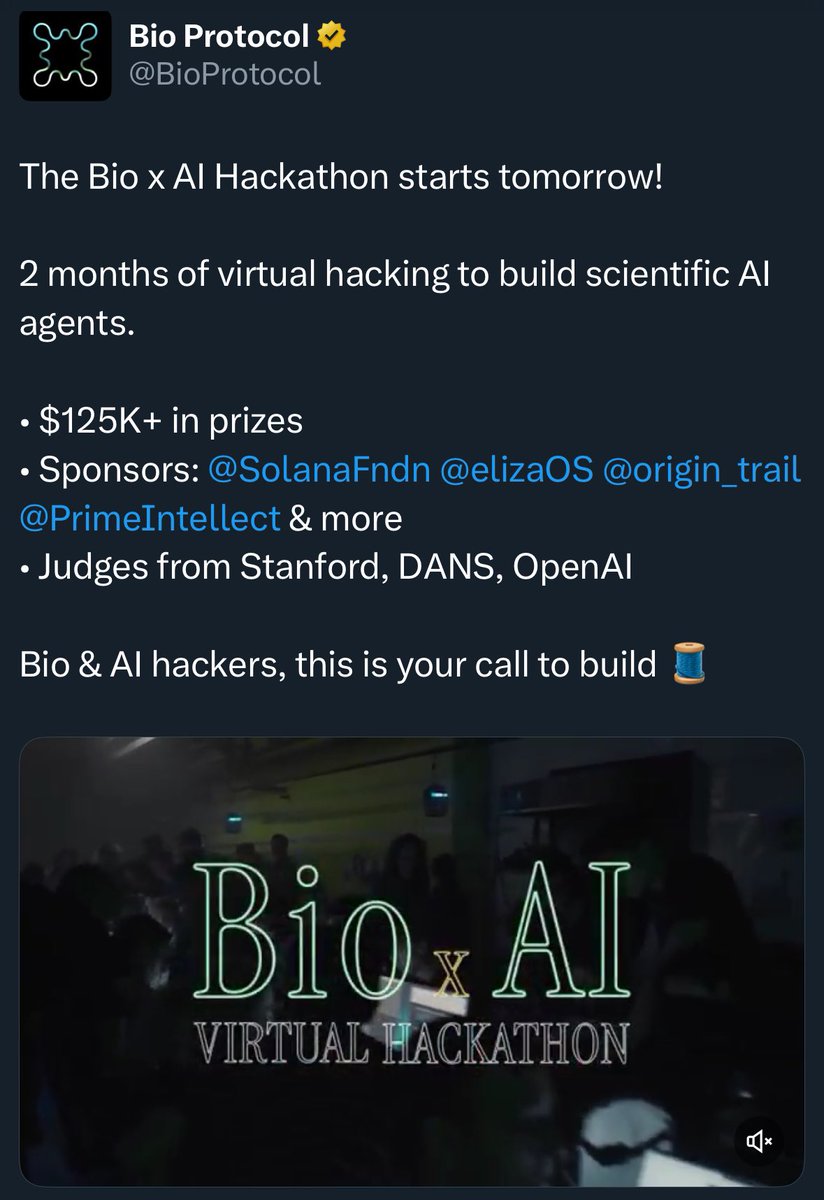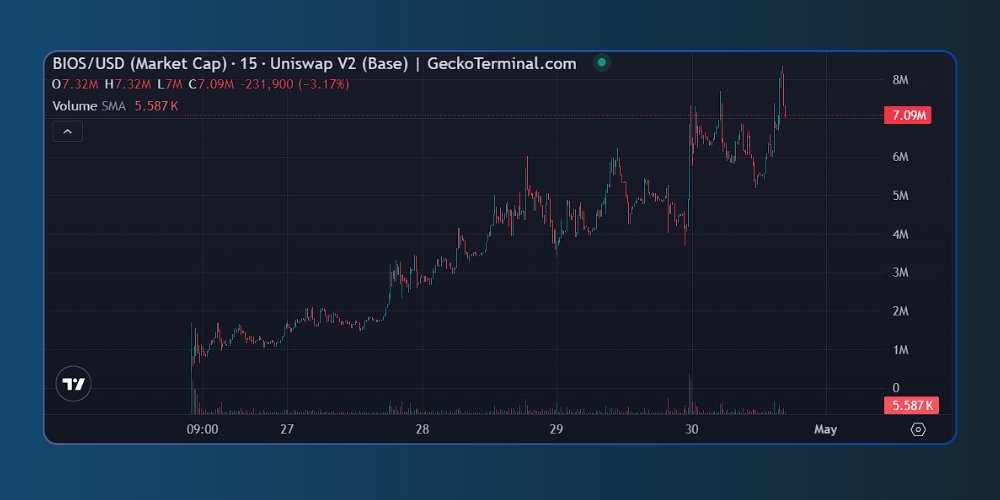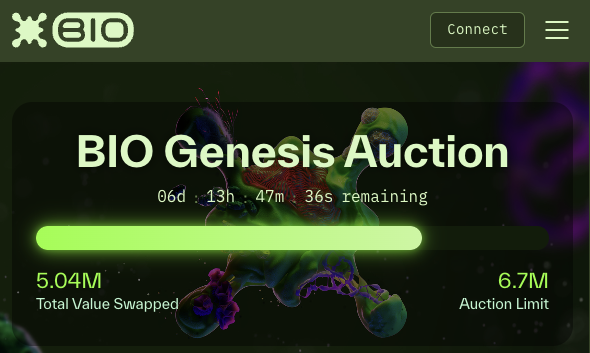
BIO
BIO Kurs
$0,058810
+$0,00018000
(+0,30 %)
Preisänderung von 00:00 Uhr UTC bis jetzt

Was denken Sie heute über den BIO-Kurs?
Teilen Sie uns Ihre Meinung mit: Daumen nach oben, wenn Sie BTC und seinen Wert positiv sehen, oder Daumen nach unten, wenn Sie ihn negativ einschätzen.
Abstimmen und Ergebnisse anzeigen
Haftungsausschluss
Der soziale Inhalt auf dieser Seite („Inhalt”), einschließlich, aber nicht beschränkt auf Tweets und Statistiken, die von LunarCrush bereitgestellt werden, stammt von Dritten und wird „wie er ist” ausschließlich zu Informationszwecken bereitgestellt. OKX übernimmt keine Garantie für die Qualität oder Richtigkeit des Inhalts, und der Inhalt spiegelt nicht die Ansichten von OKX wider. Die Inhalte dienen nicht dazu, (i) Anlageberatung oder Empfehlungen zu geben, (ii) ein Angebot oder eine Aufforderung zum Kauf, Verkauf oder Halten digitaler Vermögenswerte darzustellen oder (iii) finanzielle, buchhalterische, rechtliche oder steuerliche Beratung zu leisten. Digitale Assets, einschließlich Stablecoins und NFTs, bergen ein hohes Risiko, können stark schwanken und sogar wertlos werden. Preis und Leistung digitaler Vermögenswerte sind nicht garantiert und können sich ohne Vorankündigung ändern.
OKX gibt keine Anlage- oder Vermögensempfehlungen. Du solltest gut abwägen, ob der Handel und das Halten von digitalen Assets angesichts deiner finanziellen Situation sinnvoll ist. Bei Fragen zu deiner individuellen Situation wende dich bitte an deinen Rechts-/Steuer- oder Anlagenexperten. Weitere Einzelheiten findest du in unseren Nutzungsbedingungen und der Risikowarnung. Durch die Nutzung der Website eines Drittanbieters („TPW“) akzeptieren Sie, dass jegliche Nutzung der TPW den Bedingungen der TPW unterliegt. Sofern nicht ausdrücklich schriftlich angegeben, steht OKX einschließlich seiner verbundenen Unternehmen („OKX“) in keinerlei Verbindung zum Eigentümer oder Betreiber der TPW. Sie stimmen zu, dass OKX nicht für Verluste, Schäden oder sonstige Folgen haftet, die sich aus Ihrer Nutzung der TPW ergeben. Bitte beachte, dass die Nutzung einer TPW zu einem Verlust oder einer Minderung deiner Assets führen kann. Das Produkt ist möglicherweise nicht in allen Ländern verfügbar.
OKX gibt keine Anlage- oder Vermögensempfehlungen. Du solltest gut abwägen, ob der Handel und das Halten von digitalen Assets angesichts deiner finanziellen Situation sinnvoll ist. Bei Fragen zu deiner individuellen Situation wende dich bitte an deinen Rechts-/Steuer- oder Anlagenexperten. Weitere Einzelheiten findest du in unseren Nutzungsbedingungen und der Risikowarnung. Durch die Nutzung der Website eines Drittanbieters („TPW“) akzeptieren Sie, dass jegliche Nutzung der TPW den Bedingungen der TPW unterliegt. Sofern nicht ausdrücklich schriftlich angegeben, steht OKX einschließlich seiner verbundenen Unternehmen („OKX“) in keinerlei Verbindung zum Eigentümer oder Betreiber der TPW. Sie stimmen zu, dass OKX nicht für Verluste, Schäden oder sonstige Folgen haftet, die sich aus Ihrer Nutzung der TPW ergeben. Bitte beachte, dass die Nutzung einer TPW zu einem Verlust oder einer Minderung deiner Assets führen kann. Das Produkt ist möglicherweise nicht in allen Ländern verfügbar.
Marktinformationen zu BIO
Marktkapitalisierung
Die Marktkapitalisierung wird durch Multiplikation der Umlaufmenge des Coins mit dem letzten Preis berechnet.
Marktkapitalisierung = Umlaufmenge × letzter Preis
Marktkapitalisierung = Umlaufmenge × letzter Preis
Umlaufmenge
Gesamtmenge eines Coins, die auf dem Markt öffentlich verfügbar ist.
Ranking der Marktkapitalisierung
Platzierung des Coins in Bezug auf die Marktkapitalisierung.
Allzeithoch
Höchster Preis, den ein Coin in seiner Handelsgeschichte erreicht hat.
Allzeittief
Niedrigster Preis, den ein Coin in seiner Handelshistorie erreicht hat.
Marktkapitalisierung
$97,66M
Umlaufmenge
1.659.229.508 BIO
49,97 % von
3.320.000.000 BIO
Ranking der Marktkapitalisierung
--
Prüfungen
CertiK
Letzte Prüfung: --
24-Std.-Hoch
$0,061260
24-Std.-Tief
$0,056850
Allzeithoch
$0,90750
-93,52 % (-$0,84869)
Letzte Aktualisierung: 3. Jan. 2025
Allzeittief
$0,040470
+45,31 % (+$0,018340)
Letzte Aktualisierung: 17. Apr. 2025
BIO-Feed
Der folgende Inhalt stammt von .

comet
Hören Sie sich das an und lernen Sie. Alles, was CZ besprochen hat, ist alles, was @BioProtocol tut
Und ihr Hackathon, der von Solana gesponsert wird, beginnt morgen
Ihr Zeitfenster, um $bio unter 0,10 $ zu akkumulieren, schließt sich


wale.moca 🐳
In seinem jüngsten Interview mit Farokh verrät CZ, welche Teile der Branche ihn am meisten begeistern (es sind keine Memecoins):
8.544
113

Graeme 🍅
Könnte dies das erste 100-fache von Virtuals' Genesis-Launchpad sein?
Der Handelsagent $BIO (@BasisOS) ist seit TGE auf Kreuzfahrt und hat gerade sein "Content Mining"-Programm gestartet.
Mit einem Preis von derzeit 7 Millionen US-Dollar (56x ab dem Start) ebnet das BIOS den Weg für zukünftige Markteinführungen von KI-Agenten.
Original anzeigen
19.062
0

Ash
Ist es bald an der Zeit, sich zu verpflichten?
Bisher starke CEX-Coins
$sui
$layer
$virtuals
$kaito
$hype
$would
$plume
Starke Memes mit zusätzlichem Nutzen
$bonk
$trump
On-Chain-Revival
$fartcoin
$rei
$alch
$house
Sonstiges
$bera weitere dApps TGE + boyco entsperrt die Kosten im Preis
$bio immer noch der beste Desci-Proxy?
$xrp XRPFi-Abschlussarbeit braut sich zusammen
$pol Agglayer
Original anzeigen125.482
90

Forte reposted

Solana
Die erste BioDAO von Solana hat möglicherweise gerade die erste Behandlung einer tödlichen seltenen Krankheit aufgedeckt.
DeSci beschleunigt die Medizin mit der Geschwindigkeit von Solana 🧪

Bio Protocol
Wie lange werden wir noch sehen, wie Eltern GoFundMes starten, nur um ihre Kinder am Leben zu erhalten?
AARS2-Mangel kann tödlich sein → Keine Behandlung, wird von der Pharmaindustrie ignoriert
@endrarediseases - die 1. BioDAO auf @solana - hat gerade umsetzbare Treffer bei einer Behandlung aufgedeckt
Das ändert alles 👇
163.201
793

zac.eth 🧙🏻♂️♦️
Noch 6 Tage, um an der $BIO Token Genesis von @bioprotocol teilzunehmen (Ich habe teilgenommen)
👉
$BIO schafft eine neue Kategorie von Kryptowährungen - "Science Finance" oder SciFi - eine Symbiose aus DeFi und DeSci
Das Protokoll zielt darauf ab, Anreize anzugleichen und das Kapital in BioDAOs zu erhöhen, die Liquidität für SciFi zu vertiefen und das Tempo der Onchain-Wissenschaft zu beschleunigen. 🧑🔬🧪
Berechtigte Token, die gegen $BIO getauscht werden können:
• $VITA - @vita_dao
• $NEURON - @Cerebrum_DAO
• $HAIR - @HairDAO_
• $GROW - @valley_dao
• $ATH - @athena_DAO_
• $CRYO - @cryodao
• $RSC - @ResearchHub
• $PSY - @psy_dao
📜 Weitere Informationen:
🔗 Alpha:
Original anzeigen
36.178
69
BIO-Rechner


Kurs von BIO heute in USD
Der aktuelle Preis von BIO liegt bei $0,058810. Seit 00:00 Uhr ist BIO um +0,31 % gestiegen. Die Währung hat derzeit eine Umlaufmenge von 1.659.229.508 BIO und eine maximale Versorgung von 3.320.000.000 BIO, was eine vollständig verwässerte Marktkapitalisierung von $97,66M ergibt. In der Rangliste der Marktkapitalisierung belegt der BIO-Coin derzeit die Position 0. Der BIO/USD-Kurs wird in Echtzeit aktualisiert.
Heute
+$0,00018000
+0,30 %
7 Tage
-$0,01366
-18,85 %
30 Tage
+$0,0015100
+2,63 %
3 Monate
-$0,06899
-53,99 %
Beliebte BIO-Konvertierungen
Letzte Aktualisierung: 08.05.2025, 08:25
| 1 BIO in USD | 0,058860 $ |
| 1 BIO in EUR | 0,052066 € |
| 1 BIO in PHP | 3,2697 ₱ |
| 1 BIO in IDR | 971,45 Rp |
| 1 BIO in GBP | 0,044282 £ |
| 1 BIO in CAD | 0,081433 $ |
| 1 BIO in AED | 0,21619 AED |
| 1 BIO in VND | 1.528,04 ₫ |
Über BIO (BIO)
Die angegebene Bewertung ist eine aggregierte Bewertung, die von OKX aus den angegebenen Quellen gesammelt wurde und nur zu Informationszwecken dient. OKX übernimmt keine Garantie für die Qualität oder Richtigkeit der Bewertungen. Es ist nicht beabsichtigt, (i) eine Anlageberatung oder -empfehlung, (ii) ein Angebot oder eine Aufforderung zum Kauf, Verkauf oder Halten von digitalen Vermögenswerten oder (iii) eine Finanz-, Buchhaltungs-, Rechts- oder Steuerberatung anzubieten. Digitale Vermögenswerte, einschließlich Stablecoins und NFTs, sind mit einem hohen Risiko behaftet, ihr Wert kann stark schwanken und sie können sogar wertlos werden. Der Preis und die Wertentwicklung der digitalen Vermögenswerte sind nicht garantiert und können sich ohne vorherige Ankündigung ändern. Ihre digitalen Vermögenswerte sind nicht durch eine Versicherung gegen mögliche Verluste abgedeckt. Historische Renditen sind kein Indikator für zukünftige Renditen. OKX garantiert keine Rendite, Rückzahlung von Kapital oder Zinsen. OKX gibt keine Anlage- oder Vermögensempfehlungen ab. Sie sollten sorgfältig abwägen, ob der Handel mit oder das Halten von digitalen Vermögenswerten angesichts Ihrer finanziellen Situation für Sie geeignet ist. Bitte konsultieren Sie Ihren Rechts-/Steuer-/Anlageexperten, wenn Sie Fragen bezüglich Ihrer individuellen Gegebenheiten haben.
Mehr anzeigen
- Offizielle Website
- Whitepaper
- Block Explorer
Über Websites von Drittanbietern
Über Websites von Drittanbietern
Durch die Nutzung der Website eines Drittanbieters (Third-Party Website, „TPW“) akzeptieren Sie, dass jegliche Nutzung der TPW den Bedingungen der TPW unterliegt und durch diese geregelt wird. Sofern nicht ausdrücklich schriftlich anders angegeben, stehen OKX und seine verbundenen Unternehmen („OKX“) in keiner Weise mit dem Eigentümer oder Betreiber der TPW in Verbindung. Sie erklären sich damit einverstanden, dass OKX nicht für Verluste, Schäden und sonstige Folgen haftet, die sich aus Ihrer Nutzung der TPW ergeben. Bitte beachten Sie, dass die Nutzung einer TPW zu einem Verlust oder einer Minderung Ihres Vermögens führen kann.
Häufig gestellte Fragen zum BIO-Preis
Wie viel ist 1 BIO heute wert?
Aktuell ist ein BIO $0,058810 wert. Wenn Sie Antworten und Einblicke in das Preisgeschehen von BIO suchen, sind Sie hier genau an der richtigen Stelle. Entdecken Sie die neuesten BIO-Charts und handeln Sie verantwortungsbewusst mit OKX.
Was ist eine Kryptowährung?
Kryptowährungen, wie etwa BIO, sind digitale Vermögenswerte, die auf einem öffentlichen Hauptbuch namens Blockchains betrieben werden. Erfahren Sie mehr über die auf OKX angebotenen Coins und Tokens sowie deren unterschiedlichen Eigenschaften, einschließlich Live-Preisen und Charts in Echtzeit.
Wann wurden Kryptowährungen erfunden?
Dank der Finanzkrise von 2008 ist das Interesse an einem dezentralen Finanzwesen rasant gestiegen. Bitcoin bot als sicherer digitaler Vermögenswert auf einem dezentralen Netzwerk eine neuartige Lösung. Seitdem wurden auch viele andere Token, wie etwa BIO, erstellt.
Wird der Preis von BIO heute steigen?
Auf unserer BIO-Seite für Preisprognosen finden Sie Prognosen zukünftiger Preise und können Ihre Preisziele bestimmen.
ESG-Offenlegung
ESG-Regulierungen (Umwelt, Soziales und Governance) für Krypto-Vermögenswerte zielen darauf ab, ihre Umweltauswirkungen (z. B. energieintensives Mining) zu adressieren, Transparenz zu fördern und ethische Governance-Praktiken zu gewährleisten, um die Krypto-Industrie mit breiteren Nachhaltigkeits- und gesellschaftlichen Zielen in Einklang zu bringen. Diese Vorschriften fördern die Compliance mit Standards, die Risiken mindern und das Vertrauen in digitale Vermögenswerte stärken.
Details zum Vermögenswert
Name
OKcoin Europe LTD
Kennung der relevanten juristischen Person
54930069NLWEIGLHXU42
Name des Krypto-Vermögenswerts
bio_protocol
Konsensmechanismus
bio_protocol is present on the following networks: ethereum, solana.
The Ethereum network uses a Proof-of-Stake Consensus Mechanism to validate new transactions on the blockchain. Core Components 1. Validators: Validators are responsible for proposing and validating new blocks. To become a validator, a user must deposit (stake) 32 ETH into a smart contract. This stake acts as collateral and can be slashed if the validator behaves dishonestly. 2. Beacon Chain: The Beacon Chain is the backbone of Ethereum 2.0. It coordinates the network of validators and manages the consensus protocol. It is responsible for creating new blocks, organizing validators into committees, and implementing the finality of blocks. Consensus Process 1. Block Proposal: Validators are chosen randomly to propose new blocks. This selection is based on a weighted random function (WRF), where the weight is determined by the amount of ETH staked. 2. Attestation: Validators not proposing a block participate in attestation. They attest to the validity of the proposed block by voting for it. Attestations are then aggregated to form a single proof of the block’s validity. 3. Committees: Validators are organized into committees to streamline the validation process. Each committee is responsible for validating blocks within a specific shard or the Beacon Chain itself. This ensures decentralization and security, as a smaller group of validators can quickly reach consensus. 4. Finality: Ethereum 2.0 uses a mechanism called Casper FFG (Friendly Finality Gadget) to achieve finality. Finality means that a block and its transactions are considered irreversible and confirmed. Validators vote on the finality of blocks, and once a supermajority is reached, the block is finalized. 5. Incentives and Penalties: Validators earn rewards for participating in the network, including proposing blocks and attesting to their validity. Conversely, validators can be penalized (slashed) for malicious behavior, such as double-signing or being offline for extended periods. This ensures honest participation and network security.
Solana uses a unique combination of Proof of History (PoH) and Proof of Stake (PoS) to achieve high throughput, low latency, and robust security. Here’s a detailed explanation of how these mechanisms work: Core Concepts 1. Proof of History (PoH): Time-Stamped Transactions: PoH is a cryptographic technique that timestamps transactions, creating a historical record that proves that an event has occurred at a specific moment in time. Verifiable Delay Function: PoH uses a Verifiable Delay Function (VDF) to generate a unique hash that includes the transaction and the time it was processed. This sequence of hashes provides a verifiable order of events, enabling the network to efficiently agree on the sequence of transactions. 2. Proof of Stake (PoS): Validator Selection: Validators are chosen to produce new blocks based on the number of SOL tokens they have staked. The more tokens staked, the higher the chance of being selected to validate transactions and produce new blocks. Delegation: Token holders can delegate their SOL tokens to validators, earning rewards proportional to their stake while enhancing the network's security. Consensus Process 1. Transaction Validation: Transactions are broadcast to the network and collected by validators. Each transaction is validated to ensure it meets the network’s criteria, such as having correct signatures and sufficient funds. 2. PoH Sequence Generation: A validator generates a sequence of hashes using PoH, each containing a timestamp and the previous hash. This process creates a historical record of transactions, establishing a cryptographic clock for the network. 3. Block Production: The network uses PoS to select a leader validator based on their stake. The leader is responsible for bundling the validated transactions into a block. The leader validator uses the PoH sequence to order transactions within the block, ensuring that all transactions are processed in the correct order. 4. Consensus and Finalization: Other validators verify the block produced by the leader validator. They check the correctness of the PoH sequence and validate the transactions within the block. Once the block is verified, it is added to the blockchain. Validators sign off on the block, and it is considered finalized. Security and Economic Incentives 1. Incentives for Validators: Block Rewards: Validators earn rewards for producing and validating blocks. These rewards are distributed in SOL tokens and are proportional to the validator’s stake and performance. Transaction Fees: Validators also earn transaction fees from the transactions included in the blocks they produce. These fees provide an additional incentive for validators to process transactions efficiently. 2. Security: Staking: Validators must stake SOL tokens to participate in the consensus process. This staking acts as collateral, incentivizing validators to act honestly. If a validator behaves maliciously or fails to perform, they risk losing their staked tokens. Delegated Staking: Token holders can delegate their SOL tokens to validators, enhancing network security and decentralization. Delegators share in the rewards and are incentivized to choose reliable validators. 3. Economic Penalties: Slashing: Validators can be penalized for malicious behavior, such as double-signing or producing invalid blocks. This penalty, known as slashing, results in the loss of a portion of the staked tokens, discouraging dishonest actions.
Anreizmechanismen und anfallende Gebühren
bio_protocol is present on the following networks: ethereum, solana.
Ethereum, particularly after transitioning to Ethereum 2.0 (Eth2), employs a Proof-of-Stake (PoS) consensus mechanism to secure its network. The incentives for validators and the fee structures play crucial roles in maintaining the security and efficiency of the blockchain. Incentive Mechanisms 1. Staking Rewards: Validator Rewards: Validators are essential to the PoS mechanism. They are responsible for proposing and validating new blocks. To participate, they must stake a minimum of 32 ETH. In return, they earn rewards for their contributions, which are paid out in ETH. These rewards are a combination of newly minted ETH and transaction fees from the blocks they validate. Reward Rate: The reward rate for validators is dynamic and depends on the total amount of ETH staked in the network. The more ETH staked, the lower the individual reward rate, and vice versa. This is designed to balance the network's security and the incentive to participate. 2. Transaction Fees: Base Fee: After the implementation of Ethereum Improvement Proposal (EIP) 1559, the transaction fee model changed to include a base fee that is burned (i.e., removed from circulation). This base fee adjusts dynamically based on network demand, aiming to stabilize transaction fees and reduce volatility. Priority Fee (Tip): Users can also include a priority fee (tip) to incentivize validators to include their transactions more quickly. This fee goes directly to the validators, providing them with an additional incentive to process transactions efficiently. 3. Penalties for Malicious Behavior: Slashing: Validators face penalties (slashing) if they engage in malicious behavior, such as double-signing or validating incorrect information. Slashing results in the loss of a portion of their staked ETH, discouraging bad actors and ensuring that validators act in the network's best interest. Inactivity Penalties: Validators also face penalties for prolonged inactivity. This ensures that validators remain active and engaged in maintaining the network's security and operation. Fees Applicable on the Ethereum Blockchain 1. Gas Fees: Calculation: Gas fees are calculated based on the computational complexity of transactions and smart contract executions. Each operation on the Ethereum Virtual Machine (EVM) has an associated gas cost. Dynamic Adjustment: The base fee introduced by EIP-1559 dynamically adjusts according to network congestion. When demand for block space is high, the base fee increases, and when demand is low, it decreases. 2. Smart Contract Fees: Deployment and Interaction: Deploying a smart contract on Ethereum involves paying gas fees proportional to the contract's complexity and size. Interacting with deployed smart contracts (e.g., executing functions, transferring tokens) also incurs gas fees. Optimizations: Developers are incentivized to optimize their smart contracts to minimize gas usage, making transactions more cost-effective for users. 3. Asset Transfer Fees: Token Transfers: Transferring ERC-20 or other token standards involves gas fees. These fees vary based on the token's contract implementation and the current network demand.
Solana uses a combination of Proof of History (PoH) and Proof of Stake (PoS) to secure its network and validate transactions. Here’s a detailed explanation of the incentive mechanisms and applicable fees: Incentive Mechanisms 4. Validators: Staking Rewards: Validators are chosen based on the number of SOL tokens they have staked. They earn rewards for producing and validating blocks, which are distributed in SOL. The more tokens staked, the higher the chances of being selected to validate transactions and produce new blocks. Transaction Fees: Validators earn a portion of the transaction fees paid by users for the transactions they include in the blocks. This provides an additional financial incentive for validators to process transactions efficiently and maintain the network's integrity. 5. Delegators: Delegated Staking: Token holders who do not wish to run a validator node can delegate their SOL tokens to a validator. In return, delegators share in the rewards earned by the validators. This encourages widespread participation in securing the network and ensures decentralization. 6. Economic Security: Slashing: Validators can be penalized for malicious behavior, such as producing invalid blocks or being frequently offline. This penalty, known as slashing, involves the loss of a portion of their staked tokens. Slashing deters dishonest actions and ensures that validators act in the best interest of the network. Opportunity Cost: By staking SOL tokens, validators and delegators lock up their tokens, which could otherwise be used or sold. This opportunity cost incentivizes participants to act honestly to earn rewards and avoid penalties. Fees Applicable on the Solana Blockchain 7. Transaction Fees: Low and Predictable Fees: Solana is designed to handle a high throughput of transactions, which helps keep fees low and predictable. The average transaction fee on Solana is significantly lower compared to other blockchains like Ethereum. Fee Structure: Fees are paid in SOL and are used to compensate validators for the resources they expend to process transactions. This includes computational power and network bandwidth. 8. Rent Fees: State Storage: Solana charges rent fees for storing data on the blockchain. These fees are designed to discourage inefficient use of state storage and encourage developers to clean up unused state. Rent fees help maintain the efficiency and performance of the network. 9. Smart Contract Fees: Execution Costs: Similar to transaction fees, fees for deploying and interacting with smart contracts on Solana are based on the computational resources required. This ensures that users are charged proportionally for the resources they consume.
Beginn des Zeitraums, auf die sich die Angaben beziehen
2024-04-20
Ende des Zeitraums, auf die sich die Angaben beziehen
2025-04-20
Energiebericht
Energieverbrauch
1246.55846 (kWh/a)
Quellen und Verfahren im Bezug auf den Energieverbrauch
The energy consumption of this asset is aggregated across multiple components:
To determine the energy consumption of a token, the energy consumption of the network(s) ethereum, solana is calculated first. Based on the crypto asset's gas consumption per network, the share of the total consumption of the respective network that is assigned to this asset is defined. When calculating the energy consumption, we used - if available - the Functionally Fungible Group Digital Token Identifier (FFG DTI) to determine all implementations of the asset of question in scope and we update the mappings regulary, based on data of the Digital Token Identifier Foundation.
BIO-Rechner













